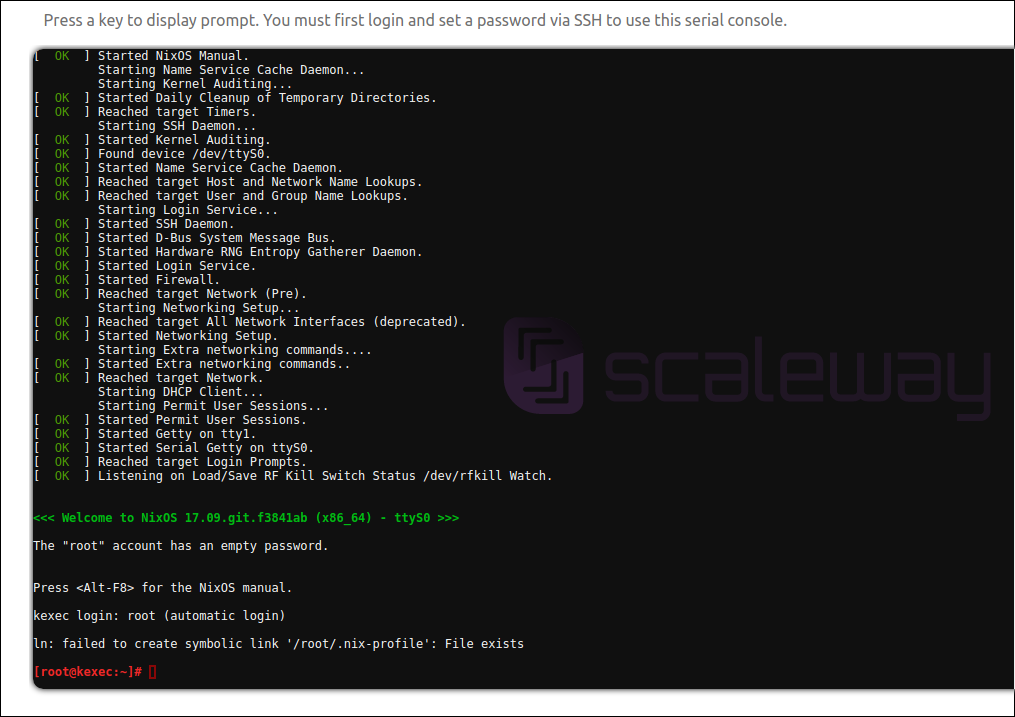Install NixOS on Scaleway X86 Virtual Cloud Server
Appearance
Preparation
Build NixOS kexec Tarball
- git clone https://github.com/cleverca22/nix-tests.git
- cd nix-tests/kexec/
- Edit configuration.nix according to your needs
- example configuration.nix (notice that ./autoreboot.nix has been removed from the imports)
# new cmd: nix-build '<nixpkgs/nixos>' -A config.system.build.kexec_tarball -I nixos-config=./configuration.nix -Q -j 4
{ lib, pkgs, config, ... }:
with lib;
{
imports = [ <nixpkgs/nixos/modules/installer/netboot/netboot-minimal.nix> ./kexec.nix ./justdoit.nix ];
#boot.supportedFilesystems = [ "zfs" ];
boot.loader.grub.enable = false;
boot.kernelParams = [
"console=ttyS0,115200" # allows certain forms of remote access, if the hardware is setup right
"panic=30" "boot.panic_on_fail" # reboot the machine upon fatal boot issues
];
systemd.services.sshd.wantedBy = mkForce [ "multi-user.target" ];
networking.hostName = "kexec";
# example way to embed an ssh pubkey into the tar
users.users.root.openssh.authorizedKeys.keys = [ "ssh-rsa AAAAB3.... Your-SSH-key" ];
}
- Build kexec tarball like shown at the beginning of the file:
nix-build '<nixpkgs/nixos>' -A config.system.build.kexec_tarball -I nixos-config=./configuration.nix -Q -j 4
Create Scaleway Instance
- Open Scaleway "Create a server" page
- Enter name
- Select region
- Select server type
- This will only work for the V and X types of servers (e.g. VC1M or X64-15GB)
- I selected a VC1M for the rest of this guide
- Select "Debian Sid" from the distributions tab
- At the time of writing of this guide the Ubuntu Xenial did not have a kexec enabled kernel
- create server
- wait until server has been provisioned and is done booting
- Can be checked by looking at the console
Start NixOS kexec System
- copy the results of the nix-build to the server
scp result/tarball/nixos-system-x86_64-linux.tar.xz root@51.YY.XX.93:
- ssh into the server
- extract the tarball into /
cd /
tar -xf /root/nixos-system-x86_64-linux.tar.xz
- execute the kexec_nixos script
./kexec_nixos - You should see output like this:
root@scalenix:/# ./kexec_nixos
++ mktemp -d
+ cd /tmp/tmp.iDXuzu8Ec4
+ pwd
/tmp/tmp.iDXuzu8Ec4
+ mkdir initrd
+ pushd initrd
/tmp/tmp.iDXuzu8Ec4/initrd /tmp/tmp.iDXuzu8Ec4
+ cat /ssh_pubkey
cat: /ssh_pubkey: No such file or directory
+ find -type f
+ cpio -o -H newc
+ gzip -9
1 block
+ popd
/tmp/tmp.iDXuzu8Ec4
+ cat /nix/store/2lmw78k2ralvpn6fa270b53nz1xgqk8b-image/initrd extra.gz
+ kexec -l /nix/store/2lmw78k2ralvpn6fa270b53nz1xgqk8b-image/kernel --initrd=final.gz '--append=init=/nix/store/sv9hndbkrdxr1psi2jr82hkm1ba0j8bx-nixos-system-kexec-17.09.git.f3841ab/init loglevel=4 console=ttyS0,115200 panic=30 boot.panic_on_fail'
+ sync
+ echo 'executing kernel, filesystems will be improperly umounted'
executing kernel, filesystems will be improperly umounted
+ kexec -e
packet_write_wait: Connection to 51.15.71.93 port 22: Broken pipe
- Once the ssh connection is broken take a look at the servers console in the webinterface
Installing NixOS
Scaleway starts up VMs differently than other providers. This results in the following things that need to be done so that NixOS can boot:
- Scaleway start scripts mount /dev/vda -> No partitioning of the root volume possible
- You have to configure 2 "tags" in the Scaleway configuration of the system to tell the start script which kernel and initrd to load
- KEXEC_KERNEL=/boot/nixos-kernel
- KEXEC_INITRD=/boot/nixos-initrd
- Screenshot: File:Scaleway-tags.png
- Mount /dev/vda
mount /dev/vda /mnt/ - Delete all existing data from the previous Debian system
rm -rf /mnt/* - Create mountpoint for /nix on the 2nd volume
mkdir /mnt/nix - Create filesystem on the 2nd volume
mkfs.ext4 /dev/vdb -L nixstore - Mount 2nd volume
mount /dev/vdb /mnt/nix/ - Generate NixOS config
nixos-generate-config --root /mnt - Edit /mnt/etc/nixos/configuration.nix
- Remove the default boot.loader.grub entries
- Add the following
boot.loader.initScript.enable = true;
boot.loader.generationsDir.enable = true;
boot.loader.generationsDir.copyKernels = true;
boot.loader.grub.enable = false;
- Make sure to add users/keys to access the system later via SSH
- Install NixOS
nixos-install --root /mnt- This might take some time
- Set root password at the end of
- Create symlink in /mnt from init to boot/nixos-init
cd /mnt
ln -s boot/nixos-init init
- reboot

